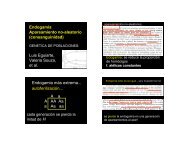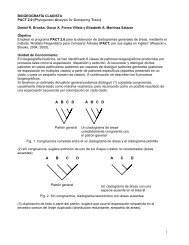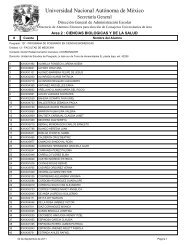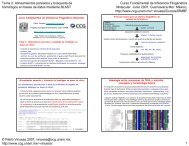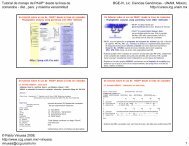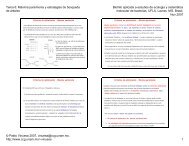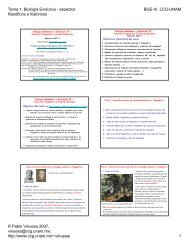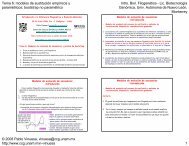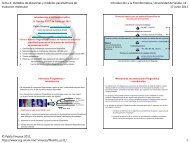El flujo génico y la estructura de las poblaciones. - CCG-UNAM
El flujo génico y la estructura de las poblaciones. - CCG-UNAM
El flujo génico y la estructura de las poblaciones. - CCG-UNAM
You also want an ePaper? Increase the reach of your titles
YUMPU automatically turns print PDFs into web optimized ePapers that Google loves.
<strong>El</strong> <strong>flujo</strong> génico y <strong>la</strong><br />
<strong>estructura</strong> <strong>de</strong> <strong>la</strong>s<br />
pob<strong>la</strong>ciones.<br />
Quinta Sesión<br />
GENETICA DE<br />
POBLACIONES:<br />
Luis Eguiarte y<br />
<strong>El</strong> <strong>flujo</strong> génico y <strong>la</strong> <strong>estructura</strong> <strong>de</strong><br />
<strong>la</strong>s pob<strong>la</strong>ciones.<br />
<strong>El</strong> mo<strong>de</strong>lo continente-is<strong>la</strong> <strong>de</strong> <strong>flujo</strong><br />
génico.<br />
Estimaciones directas e<br />
indirectas <strong>de</strong> <strong>flujo</strong> génico.<br />
<strong>El</strong> efecto Wahlund.<br />
Los estadísticos F <strong>de</strong> Wright.<br />
Flujo génico y <strong>de</strong>riva.<br />
TLEM09<br />
Luis Eguiarte, Valeria Souza<br />
TLEM09 Luis Eguiarte, Valeria Souza<br />
Valeria Souza<br />
FLUJO GENETICO gene flow:<br />
Es <strong>la</strong> vio<strong>la</strong>ción al supuesto <strong>de</strong>l equilibrio <strong>de</strong> Hardy-Weinberg<br />
que se refiere al “ais<strong>la</strong>miento” <strong>de</strong> <strong>la</strong> pob<strong>la</strong>ción.<br />
Es <strong>la</strong> incorporación <strong>de</strong> genes a nuestra poza génica<br />
provenientes <strong>de</strong> una o más pob<strong>la</strong>ciones diferentes<br />
(Futuyma, 1986).<br />
se<br />
.<br />
consi<strong>de</strong>ra que <strong>la</strong> especie esta formada<br />
por k subpob<strong>la</strong>ciones, con diferentes<br />
frecuencias alélicas, conectadas por diferentes<br />
tasas <strong>de</strong> migración m<br />
subpob<strong>la</strong>ciones<br />
ESPECIE<br />
En genética <strong>de</strong> pob<strong>la</strong>ciones también lo l<strong>la</strong>mamos<br />
migración<br />
m= migration rate, <strong>la</strong> tasa <strong>de</strong><br />
migración<br />
<strong>la</strong> probabilidad <strong>de</strong> que un gen tomado al azar <strong>de</strong> una<br />
subpob<strong>la</strong>ción sea un migrante<br />
TLEM09<br />
Luis Eguiarte, Valeria Souza<br />
Aa<br />
AA<br />
aa<br />
Aa<br />
AA<br />
AA<br />
AA<br />
TLEM09<br />
Aa<br />
AA aa<br />
Aa aa<br />
Aa<br />
AA<br />
a<br />
aa aa<br />
A<br />
Aa<br />
a AA<br />
A AA<br />
Aa<br />
Aa aa<br />
AA<br />
A<br />
aa<br />
Aa<br />
Aa<br />
A<br />
AA Aa<br />
AA Aa AA<br />
AA Aa<br />
Aa<br />
Aa<br />
Aa aa<br />
AA Aa<br />
Aa Aa<br />
Aa<br />
Luis Eguiarte, Valeria Souza<br />
Aa<br />
AA<br />
AA<br />
aa aa aa<br />
Aa<br />
aa<br />
AA aa<br />
AA<br />
aa aa<br />
aa<br />
aa<br />
1
TLEM09<br />
Existen diferentes<br />
posibles mo<strong>de</strong>los<br />
<strong>de</strong> <strong>la</strong> <strong>estructura</strong><br />
geográfica <strong>de</strong> <strong>la</strong>s<br />
especies.<br />
Vio<strong>la</strong>ciones al mo<strong>de</strong>lo<br />
básico,<br />
ayudan a enten<strong>de</strong>r el papel<br />
<strong>de</strong> <strong>la</strong> geografía...<br />
a | Is<strong>la</strong>nd mo<strong>de</strong>l of migration.<br />
b | Stepping-stone mo<strong>de</strong>l.<br />
c | Iso<strong>la</strong>tion by distance mo<strong>de</strong>l100,101.<br />
d | Metapopu<strong>la</strong>tion mo<strong>de</strong>l.<br />
In nature, not only do individuals move<br />
between popu<strong>la</strong>tions, but also individual<br />
popu<strong>la</strong>tions come and go over time (t) with<br />
the founding and extinction of entire<br />
popu<strong>la</strong>tions being an importantcomponent<br />
of popu<strong>la</strong>tion structure<br />
Luis Eguiarte, Valeria Souza<br />
<strong>El</strong> <strong>flujo</strong> génico homogeniza <strong>la</strong>s diferentes<br />
pob<strong>la</strong>ciones que forman a <strong>la</strong>s especies.<br />
así, el <strong>flujo</strong> génico se pue<strong>de</strong> pensar que actúa<br />
contra <strong>la</strong> <strong>de</strong>riva génica y <strong>la</strong> selección... PUEDE<br />
DISMINUIR LA ADAPTACION LOCAL<br />
pero, por otra parte, incrementa <strong>la</strong> variación<br />
genética, sobre <strong>la</strong> que pue<strong>de</strong> actuar <strong>la</strong> selección<br />
y reducir <strong>la</strong> carga genética<br />
y podría ja<strong>la</strong>r a <strong>la</strong>s pob<strong>la</strong>ciones los picos<br />
adaptativos más altos <strong>de</strong>l mo<strong>de</strong>lo <strong>de</strong>l Shifting<br />
ba<strong>la</strong>nce.<br />
TLEM09<br />
Luis Eguiarte, Valeria Souza<br />
Gene flow:<br />
In practice is closely re<strong>la</strong>ted to (and<br />
difficult to separate from):<br />
Mating systems (t, outcrossing rates, etc.).<br />
Pollen and seed dispersal (within a<br />
popu<strong>la</strong>tion).<br />
Effective popu<strong>la</strong>tion size.<br />
Hybridization<br />
P<strong>la</strong>nt mating systems (sensu <strong>la</strong>to):<br />
Self-pollination/outcrossing rate (t)<br />
Pollen dispersal<br />
Seed dispersal<br />
Gene flow, m<br />
Nm<br />
Effective popu<strong>la</strong>tion size, Ne<br />
TLEM09<br />
Luis Eguiarte, Valeria Souza<br />
TLEM09<br />
Luis Eguiarte, Valeria Souza<br />
2
incorporación <strong>de</strong> alelos a <strong>la</strong> poza génica<br />
en una so<strong>la</strong> dirección,<br />
<strong>de</strong> una fuente: continente<br />
a un sumi<strong>de</strong>ro: is<strong>la</strong><br />
m = tasa <strong>de</strong> migración<br />
proporción <strong>de</strong> migrantes<br />
<strong>de</strong>l continente a <strong>la</strong> is<strong>la</strong><br />
va <strong>de</strong> 0 a 1<br />
<strong>estructura</strong> genética = a <strong>la</strong> diferencia en frecuencias<br />
alélicas TLEM09en el espacio Luis Eguiarte, Valeria Souza<br />
TLEM09 Luis Eguiarte, Valeria Souza<br />
los que se quedan<br />
los que se llegan<br />
TLEM09<br />
Luis Eguiarte, Valeria Souza<br />
en el TLEM09 equilibrio, <strong>la</strong> ISLA Luis Eguiarte, llega Valeria a <strong>la</strong> Souza q <strong>de</strong>l continente...<br />
3
fórmu<strong>la</strong> para el cambio en n generaciones, continente-is<strong>la</strong><br />
entre más baja m,<br />
toma más tiempo<br />
más rápido al comienzo<br />
TLEM09<br />
Luis Eguiarte, Valeria Souza<br />
TLEM09<br />
Luis Eguiarte, Valeria Souza<br />
LOBO ROJO<br />
hibridiza con el coyote!<br />
m = ca. 0.075 <strong>de</strong> coyote<br />
TLEM09<br />
Luis Eguiarte, Valeria Souza<br />
usando m= 0.075, en<br />
cuanto tiempo se<br />
“vuelven coyotes”??<br />
en 50 años, 46%<br />
queda <strong>de</strong>l lobo...<br />
TLEM09<br />
Luis Eguiarte, Valeria Souza<br />
4
¿MANEJO?<br />
TLEM09 Luis Eguiarte, Valeria Souza TLEM09 Luis Eguiarte, Valeria Souza<br />
Estimación Indirecta en Pob<strong>la</strong>ciones<br />
Híbridas, 2 pob<strong>la</strong>ciones<br />
muy difícil, problemas <strong>de</strong> n, muestreo, estimación<br />
TLEM09<br />
Luis Eguiarte, Valeria Souza<br />
se necesita saber <strong>la</strong>s f alélicas originales,<br />
<strong>la</strong> final en <strong>la</strong> pob<strong>la</strong>ción híbrida y el tiempo<br />
TLEM09<br />
Luis Eguiarte, Valeria Souza<br />
5
q o = antes, q 1 =<strong>de</strong>spués, q m = <strong>la</strong> <strong>de</strong> los migrantes<br />
is<strong>la</strong> antes<br />
“continente”<br />
TLEM09<br />
Luis Eguiarte, Valeria Souza<br />
TLEM09<br />
Luis Eguiarte, Valeria Souza<br />
Datos humanos,<br />
pob<strong>la</strong>ciones en EUA <strong>de</strong> origen<br />
Africano<br />
TLEM09<br />
Luis Eguiarte, Valeria Souza<br />
TLEM09<br />
Luis Eguiarte, Valeria Souza<br />
6
Estimación indirecta <strong>de</strong> <strong>la</strong><br />
tasa <strong>de</strong> migración, cont.<br />
si 12 generaciones, m= 0.021 a 0.010<br />
TLEM09<br />
Luis Eguiarte, Valeria Souza<br />
TLEM09<br />
Luis Eguiarte, Valeria Souza<br />
Híbridas <strong>de</strong><br />
varias fuentes<br />
diferencias mitocondria<br />
(m = 0.14) y Y (m= 0.248)...<br />
TLEM09<br />
Luis Eguiarte, Valeria Souza<br />
TLEM09<br />
Luis Eguiarte, Valeria Souza<br />
7
CODIS MÉXICO 13 loci<br />
España= 55%, Amerindios=40% , Nigeria= 5%<br />
TLEM09<br />
Luis Eguiarte, Valeria Souza<br />
TLEM09<br />
Luis Eguiarte, Valeria Souza<br />
Principio <strong>de</strong> Wahlund 1928, una consecuencia<br />
<strong>de</strong> <strong>la</strong> <strong>estructura</strong>, útil para <strong>de</strong>finir los estadísticos F<br />
a veces no sabemos que hay<br />
sub<strong>estructura</strong>, pero si c/ subpob<strong>la</strong>cion frec.<br />
alélicas diferentes va a parecer que hay<br />
déficit <strong>de</strong> heterócigos<br />
TLEM09<br />
Luis Eguiarte, Valeria Souza<br />
pob A pob B total ESPERADOS<br />
p=.25 q=.75 p=.75 q=.25 p=.5 q=.5<br />
AA 6 56 62 > 50<br />
Aa 38 38 76 < 100<br />
aa 56 6 62 > 50<br />
SI NO SE SABE QUE SON DOS POBLACIONES, AUNQUE<br />
CADA UNA ESTA EN HW. EN TOTAL PARECE QUE FALTAN<br />
HETEROCIGOS!<br />
TLEM09<br />
Luis Eguiarte, Valeria Souza<br />
8
ESTADISTICOS F DE WRIGHT, a partir <strong>de</strong> Walhund<br />
Fit = Fis + (1-Fis) Fst<br />
Ho promedio <strong>de</strong> <strong>la</strong> heterocigosis<br />
observadas<br />
Hs promedio <strong>de</strong> <strong>la</strong> heterocigosis<br />
esperadas en cada pob<strong>la</strong>ción,<br />
<strong>de</strong> sus p y q <strong>de</strong> cada una<br />
los estimadores más importantes <strong>de</strong> dif. en estudios<br />
TLEM09<br />
Luis Eguiarte, Valeria Souza<br />
empíricos<br />
TLEM09<br />
Ht <strong>la</strong> heterocigosis <strong>de</strong>l promedio<br />
<strong>de</strong> <strong>la</strong>s p y q <strong>de</strong> toda <strong>la</strong> pob<strong>la</strong>ción<br />
como un todo!<br />
Luis Eguiarte, Valeria Souza<br />
Ho promedio <strong>de</strong> <strong>la</strong> heterocigosis observadas en c/pob<strong>la</strong>ción<br />
Hs . promedio <strong>de</strong> <strong>la</strong> heterocigosis esperadas en cada<br />
pob<strong>la</strong>ción, <strong>de</strong> sus p y q <strong>de</strong> cada una<br />
Ht <strong>la</strong> heterocigosis <strong>de</strong>l promedio <strong>de</strong> <strong>la</strong>s p y q <strong>de</strong> toda <strong>la</strong><br />
pob<strong>la</strong>ción como un todo!<br />
aa<br />
Aa<br />
AA<br />
AA<br />
Aa<br />
AA<br />
AA<br />
TLEM09<br />
Ho1<br />
Hs1<br />
q1<br />
Aa<br />
A<br />
A<br />
A<br />
A<br />
AA<br />
ESPECIE q promedio, Ht<br />
subpob<strong>la</strong>ciones<br />
Aa<br />
Ho2<br />
a<br />
Hs2 a AA<br />
AA<br />
Aa<br />
q2<br />
Aa<br />
Aa<br />
AA<br />
AA<br />
AA<br />
aa<br />
aa<br />
Aa<br />
Aa<br />
Ho3<br />
Hs3<br />
q3<br />
Aa<br />
AA aa<br />
Aa aa<br />
Aa<br />
AA<br />
aa aa<br />
Aa<br />
Aa<br />
AA<br />
Aa aa<br />
AA Aa<br />
Aa Aa<br />
Aa<br />
Ho5<br />
Hs5<br />
q5<br />
Luis Eguiarte, Valeria Souza<br />
Ho4<br />
Hs4<br />
q4<br />
Aa<br />
Ho6<br />
Hs6<br />
Aa<br />
AA<br />
AA<br />
q6<br />
aa aa aa<br />
Aa<br />
aa<br />
AA aa<br />
AA<br />
aa aa<br />
aa<br />
aa<br />
TLEM09<br />
Fit = Fis + (1-Fis) Fst<br />
Fis: efectos por endogamia/<br />
sistemas reproductivos:<br />
-1 puros hetero., 0 HW, 1<br />
endogamia total<br />
Fst: diferenciación por <strong>de</strong>riva vs.<br />
migración o selección, 0<br />
idénticas en f. alelicas, 1<br />
totalmente diferentes<br />
Fit= endogamia + <strong>de</strong>riva, -1 a 1<br />
Luis Eguiarte, Valeria Souza<br />
9
Fit = Fis + (1-Fis) Fst<br />
Fit = Fis + (1-Fis) Fst<br />
TLEM09<br />
Luis Eguiarte, Valeria Souza<br />
TLEM09<br />
Luis Eguiarte, Valeria Souza<br />
TLEM09 Luis Eguiarte, Valeria Souza TLEM09 Luis Eguiarte, Valeria Souza<br />
10
Diferencia en F st entre loci sugiere selección!<br />
10% <strong>de</strong> los genes en humanos selección<br />
diferencial<br />
(otros menos diferenciación, selección<br />
ba<strong>la</strong>nceadora!)<br />
TLEM09 Luis Eguiarte, Valeria Souza TLEM09 Luis Eguiarte, Valeria Souza<br />
¿sn ba<strong>la</strong>nceadora?<br />
Gst: estimador <strong>de</strong> <strong>la</strong> Fst a partir <strong>de</strong> H<br />
x= 0.083<br />
10% Fst >0.18<br />
SN direccional!!!<br />
<strong>de</strong>pen<strong>de</strong> <strong>de</strong>l total <strong>de</strong> variación...<br />
TLEM09<br />
Luis Eguiarte, Valeria Souza<br />
TLEM09<br />
Luis Eguiarte, Valeria Souza<br />
11
problema micros<br />
Si hay mucha variación, <strong>la</strong> Gst pue<strong>de</strong> ser MUY<br />
baja TLEM09sin que se compartan Luis Eguiarte, Valeria Souzalelos!<br />
si hay muchas variación, baja homocigosis<br />
y <strong>la</strong> TLEM09 G st aún más Luis chica, Eguiarte, Valeria baja Souza su utilidad...<br />
Otros niveles <strong>de</strong> partición! se pue<strong>de</strong>n proponer n<br />
7 pob<strong>la</strong>ciones, <strong>de</strong> tres regiones<br />
TLEM09<br />
Luis Eguiarte, Valeria Souza<br />
Hs=0.263<br />
Hr=0.357<br />
TLEM09<br />
Ht=0.647<br />
Fsr= 0.253<br />
Frt= 0.456<br />
Luis Eguiarte, Valeria Souza<br />
Ht<br />
12
el <strong>flujo</strong> génico homogeniza <strong>la</strong>s f. alélicas<br />
<strong>la</strong> <strong>de</strong>riva hace que diverjan...<br />
Fsr= 0.253<br />
Frt= 0.456<br />
casi el doble <strong>de</strong> <strong>la</strong> variación se encuentra entre regiones<br />
que TLEM09 <strong>la</strong>s subpob<strong>la</strong>ciones Luis Eguiarte, <strong>de</strong>ntro Valeria <strong>de</strong> Souzaun grupo! TLEM09 Luis Eguiarte, Valeria Souza<br />
Ba<strong>la</strong>nce Deriva- Migración<br />
TLEM09 Luis Eguiarte, Valeria Souza TLEM09 Luis Eguiarte, Valeria Souza<br />
el incremento <strong>de</strong> f por <strong>de</strong>riva , dado que ninguno <strong>de</strong> los alelos<br />
sea migrante<br />
13
si m es pequeña<br />
TLEM09 Luis Eguiarte, Valeria Souza TLEM09 Luis Eguiarte, Valeria Souza<br />
Nm= migrantes efectivos, con 1 que llegue, se evita<br />
<strong>la</strong> <strong>de</strong>riva... o no...<br />
una estimación <strong>de</strong> G st si hay n pob<strong>la</strong>ciones<br />
importante si analizamos pocas pob<strong>la</strong>ciones<br />
TLEM09<br />
Luis Eguiarte, Valeria Souza<br />
TLEM09<br />
Luis Eguiarte, Valeria Souza<br />
14
Estimación indirecta <strong>de</strong> Nm<br />
pero pue<strong>de</strong> tener sesgos si F st es chica... ca. 0.01<br />
una guía general, a “or<strong>de</strong>n <strong>de</strong> magnitud”<br />
TLEM09<br />
Luis Eguiarte, Valeria Souza<br />
TLEM09<br />
Luis Eguiarte, Valeria Souza<br />
¿en cuanto tiempo se llega al equilibrio Nm /F st ?<br />
se pue<strong>de</strong> llegar rápido a <strong>la</strong> Fst en eq.<br />
si m es gran<strong>de</strong> o N chica<br />
dinámica pura <strong>de</strong>riva, <strong>de</strong> 0 a 1..., según t y N<br />
TLEM09<br />
Luis Eguiarte, Valeria Souza<br />
TLEM09<br />
Luis Eguiarte, Valeria Souza<br />
15
TLEM09<br />
Luis Eguiarte, Valeria Souza<br />
poco <strong>flujo</strong> génico<br />
(m=0.001) hace<br />
mucho más lenta<br />
<strong>la</strong> diferenciación! TLEM09 Luis Eguiarte, Valeria Souza<br />
tiempo<br />
a ½ <strong>de</strong> Fst<br />
Efecto <strong>de</strong> <strong>la</strong> subdivisión en N e<br />
si Nm gran<strong>de</strong>, Ne casi kN<br />
pero si Nm pequeña, pue<strong>de</strong> se<br />
mucho más gran<strong>de</strong> que kN<br />
TLEM09<br />
Luis Eguiarte, Valeria Souza<br />
TLEM09<br />
Luis Eguiarte, Valeria Souza<br />
16
Resultados <strong>de</strong> Wright 1940 en el equilibrio <strong>flujo</strong>/<strong>de</strong>riva<br />
TLEM09<br />
Luis Eguiarte, Valeria Souza<br />
TLEM09<br />
Luis Eguiarte, Valeria Souza<br />
si 4Nm>>1 sólo <strong>flujo</strong><br />
Iso<strong>la</strong>tion by Distance:<br />
el ais<strong>la</strong>miento por distancia <strong>de</strong> Wright, 1943<br />
si 4Nm
Mapa<br />
Dos especies mezcaleras muy<br />
cercanas<br />
Agave potatorum y A.<br />
cupreata:<br />
“Papalometl” (ancho) y “Tobalá”<br />
A. potatorum<br />
ENRIQUE SCHEINVAR!<br />
A. cupreta<br />
TLEM09 Luis Eguiarte, Valeria Souza TLEM09 Luis Eguiarte, Valeria Souza<br />
Mezcal papalote /<br />
tobalá: 90 loci,<br />
ISSRs<br />
Xit<strong>la</strong>li Aguirre y<br />
Enrique Scheinvar<br />
Oaxaca A. potatorum<br />
Guerrero y<br />
Michoacán<br />
A. cupreata<br />
TLEM09<br />
Luis Eguiarte, Valeria Souza<br />
TLEM09<br />
Luis Eguiarte, Valeria Souza<br />
18
Variación Genética en AGAVE CUPRETA y A. POTAROUM<br />
ligeramente más alta en cupreata<br />
Pob<strong>la</strong>ción Ubicación N He (V (He) ) P (95%) (V (P) )<br />
C1 Vivero “Ayahualco” Chi<strong>la</strong>pa, Gro. 25 0.2689 (0.0008) 74.44 (0.192)<br />
C4 Vivero “La Esperanza” Chi<strong>la</strong>pa, Gro. 34 0.3043 (0.0010) 84.44 (0.133)<br />
C5 Vivero “Trapiche Viejo” Chi<strong>la</strong>pa, Gro. 41 0.3225 (0.0012) 76.67 (0.181)<br />
C2 “Ayahualco” Chi<strong>la</strong>pa, Gro. 32 0.2969 (0.0010) 74.44 (0.192)<br />
C10 “Mesones” T<strong>la</strong>pa, Gro. 41 0.3723 (0.0015) 91.11 (0.082)<br />
C13 “La Laguna” Xochipa<strong>la</strong>, Gro. 28 0.3445 (0.0013) 87.78 (0.108)<br />
C14 “Etucuaro” V. Ma<strong>de</strong>ra, Mich. 33 0.3096 (0.0011) 81.11 (0.155)<br />
Viveros Chi<strong>la</strong>pa, Gro. 100 0.3219 (0.0012) 84.44 (0.133)<br />
Silvestres Chi<strong>la</strong>pa, T<strong>la</strong>pa, Vil<strong>la</strong> Ma<strong>de</strong>ra 134 0.3566 (0.0014) 94.44 (0.053)<br />
A. cupreata Gro-Mich. 234 0.3452 (0.0013) 93.33 (0.063)<br />
P4 “San Dionisio” Sn. Dionisio Ocotepec, Oax. 22 0.2605 (0.0007) 73.33 (0.198)<br />
P6 “Albarradas” Sn. Lorenzo Albarradas, Oax. 31 0.3374 (0.0013) 85.56 (0.125)<br />
P7 “Miahatlán” Sto. Tomás Tamazu<strong>la</strong>pa, Oax. 49 0.2909 (0.0009) 83.33 (0.140)<br />
P9 “Sta. Catarina” Sta. Catarina, Oax. 48 0.2813 (0.0009) 76.67 (0.180)<br />
P10 “Yanhutit<strong>la</strong>n” Sto. Domingo Yanhuit<strong>la</strong>n, Oax. 31 0.2794 (0.0009) 82.44 (0.133)<br />
P11 “Zapotitlán” Zapotitlán Palmas, Oax. 46 0.3183 (0.0011) 87.78 (0.108)<br />
P12 “Tequistepec” Sn. Pedro yPablo Tequixtepec, Oax. 46 0.2837 (0.0009) 78.98 (0.168)<br />
P13 “Azumbil<strong>la</strong>” Chapulco, Pueb<strong>la</strong> 38 0.306 (0.0010) 88.89 (0.100)<br />
A. potatorum Oax.-Pue 311 0.3122 (0.0011) 93.33 (0.063)<br />
Total todas Gro-Oax-Mich-Pue 545 0.331 (0.0012) 96.67 (0.032)<br />
TLEM09<br />
Luis Eguiarte, Valeria Souza<br />
Variación Genética en Agave, especialmente A. cupreata y A. potarorum<br />
He, heterocigosis eserada P, proporción <strong>de</strong> loci polimórficos<br />
*<br />
* *<br />
* * * * *<br />
*<br />
*<br />
TLEM09<br />
Luis Eguiarte, Valeria Souza<br />
A pesar <strong>de</strong> manejo, no se ha perdido<br />
variación genética, ni siquiera en los viveros<br />
<strong>de</strong> Chi<strong>la</strong>pa, Guerrero<br />
pero parece estar promoviendo <strong>la</strong><br />
hibridización entre <strong>la</strong>s dos especies...<br />
Structure: Análsis Bayesiano para asignar grupos<br />
Agave cupreata ver<strong>de</strong> Agave potatorum rojo<br />
TLEM09<br />
Luis Eguiarte, Valeria Souza<br />
TLEM09<br />
Luis Eguiarte, Valeria Souza<br />
19
Diferenciación genética: mayor en A. cupreata<br />
F st = 0.1044, Nm =1.58,<br />
que en A. potatorum<br />
F st = 0.0791, Nm = 2.23<br />
esto es relevante para el manejo con conservación <strong>de</strong> los recurso<br />
genéticos y pue<strong>de</strong> servir para <strong>de</strong>finir <strong>de</strong>nomicnaciones <strong>de</strong> origen<br />
A.cupreata<br />
A.potatorum<br />
finas... TLEM09<br />
Luis Eguiarte, Valeria Souza<br />
TLEM09 Luis Eguiarte, Valeria Souza<br />
No hay<br />
ais<strong>la</strong>miento<br />
por<br />
distancia<br />
<strong>de</strong>ntro <strong>de</strong><br />
cada<br />
especie<br />
Agave cupreata y<br />
Agave potatorum<br />
juntas.<br />
Si hay ais<strong>la</strong>miento<br />
por distancia!!<br />
¿una so<strong>la</strong> especie,<br />
variación<br />
geográfica?<br />
Dendograma UPGMA basando en <strong>la</strong>s distancias genéticas <strong>de</strong> Nei (1972)<br />
P<br />
C<br />
TLEM09<br />
Luis Eguiarte, Valeria Souza<br />
TLEM09<br />
Luis Eguiarte, Valeria Souza<br />
20
Mapa<br />
Darwin Heterostilia<br />
Evolutionary Ecology of Tequi<strong>la</strong>, Mezcal and other Agaves.<br />
Dos<br />
especies<br />
incipientes?<br />
una especie<br />
variación<br />
geográfica?<br />
Luis E. Eguiarte<br />
Instituto <strong>de</strong> Ecología, Universidad Nacional Autónoma <strong>de</strong> México (<strong>UNAM</strong>), México.<br />
TLEM09<br />
Luis Eguiarte, Valeria Souza<br />
TLEM09<br />
Luis Eguiarte, Valeria Souza<br />
Rapd´s DOMINANTES<br />
5 primers, 51 “loci”<br />
Evolutionary Ecology of Tequi<strong>la</strong>, Mezcal and other Agaves.<br />
Evolutionary Ecology of Tequi<strong>la</strong>, Mezcal and other Agaves.<br />
Luis E. Eguiarte<br />
Instituto <strong>de</strong> Ecología, Universidad Nacional Luis E. Autónoma Eguiarte <strong>de</strong> México (<strong>UNAM</strong>), México.<br />
Instituto <strong>de</strong> Ecología, Universidad Nacional Autónoma <strong>de</strong> México (<strong>UNAM</strong>), México.<br />
RAPDs, niveles <strong>de</strong> variación genética<br />
altos!<br />
TLEM09<br />
Luis Eguiarte, Valeria Souza<br />
TLEM09<br />
Luis Eguiarte, Valeria Souza<br />
21
Evolutionary Ecology of Tequi<strong>la</strong>, Mezcal and other Agaves.<br />
Evolutionary Ecology of Tequi<strong>la</strong>, Mezcal and other Agaves.<br />
Evolutionary Ecology of Tequi<strong>la</strong>, Mezcal and other Agaves.<br />
Luis E. Eguiarte<br />
Instituto <strong>de</strong> Ecología, Universidad Nacional Luis E. Autónoma Eguiarte <strong>de</strong> México (<strong>UNAM</strong>), México.<br />
Instituto <strong>de</strong> Ecología, Universidad Nacional Autónoma <strong>de</strong> México (<strong>UNAM</strong>), México.<br />
Luis E. Eguiarte<br />
Instituto <strong>de</strong> Ecología, Universidad Nacional Autónoma <strong>de</strong> México (<strong>UNAM</strong>), México.<br />
mucha diferenciación, a pesar <strong>de</strong> <strong>la</strong> esca<strong>la</strong><br />
un equivalente <strong>de</strong> F st <strong>de</strong> 0.1376<br />
BASTANTE DIFRENCIACIÓN PARA<br />
LA ESCALA GEOGRÁFICA<br />
TLEM09<br />
local <strong>de</strong>l proyecto<br />
Luis Eguiarte,<br />
(20<br />
Valeria<br />
km<br />
Souza<br />
máximo)<br />
TLEM09 Luis Eguiarte, Valeria Souza<br />
TLEM09<br />
F st observada=<br />
0.1376<br />
mucha más diferenciación <strong>de</strong> <strong>la</strong><br />
esperada a 20 km comprando con especies <strong>de</strong><br />
ecología simi<strong>la</strong>r... ¿floración sincróncia por<br />
Luis Eguiarte, Valeria Souza<br />
parches? ¿limitada dispersión?<br />
TLEM09<br />
Evolutionary Ecology of Tequi<strong>la</strong>, Mezcal and other Agaves.<br />
Luis E. Eguiarte<br />
Instituto <strong>de</strong> Ecología, Universidad Nacional Autónoma <strong>de</strong> México (<strong>UNAM</strong>), México.<br />
otro datos sugieren<br />
una<br />
posible evolución al<br />
diocismo, sexos<br />
separados<br />
Luis Eguiarte, Valeria Souza<br />
¿macho?<br />
¿hembra?<br />
22
Analysis in the four<br />
species and 33<br />
popu<strong>la</strong>tions of firs,<br />
genus Abies<br />
(Pinaceae) from<br />
southern Mexico.<br />
Aguirre-P<strong>la</strong>nter et al. (2000,<br />
Am. J. of Botany 87: 362-<br />
371).<br />
Jaramillo-Correa, J. P. et al.<br />
(2008 Molecu<strong>la</strong>r Ecology.<br />
17: 2476–2490).<br />
TLEM09<br />
Luis Eguiarte, Valeria Souza<br />
Distribution of the Southern Abies:<br />
Abies guatemalensis G, Wi<strong>de</strong> N-S also <strong>El</strong> Salvador and Honduras<br />
A. religiosa R, Wi<strong>de</strong> E-W<br />
A. hickeli H Restricted S<br />
A. flinckii F, Restricted W<br />
TLEM09<br />
Luis Eguiarte, Valeria Souza<br />
Different indirect methods for the estimate of N e m<br />
from genetic variation:<br />
a) From F st = 1/ (4 N e m +1)<br />
b) From the private alleles method of S<strong>la</strong>tkin<br />
(1985):<br />
Average frequency of alleles found in only one popu<strong>la</strong>tion<br />
log10[p(1)] = a log 10 N e<br />
m + b<br />
a and b are constants <strong>de</strong>rived by simu<strong>la</strong>ted data<br />
Logic: with high gene flow, the rare alleles should be<br />
very rare<br />
c) Iso<strong>la</strong>tion by distance analysis (genetic differentiation<br />
as a function of the geographic distance), using estimates of N e<br />
m for<br />
Estimates from F st and private alleles:<br />
16 allozymic loci F st Private alleles<br />
F st N e m N e m<br />
A. flinckii R W 0.271 0.672 3.42<br />
A. guatemalensisW N-S 0.122 1.8 2.88<br />
A. hickeli R S 0.073 3.17 2.70<br />
A. religiosa W E-W 0.250 0.75 1.67<br />
Higher in private alleles, but both suggest<br />
re<strong>la</strong>tively high levels of gene flow among<br />
popu<strong>la</strong>tions.<br />
pairs<br />
TLEM09<br />
of popu<strong>la</strong>tions (M), following<br />
Luis Eguiarte,<br />
S<strong>la</strong>tkin<br />
Valeria<br />
(1993)<br />
Souza<br />
TLEM09 Luis Eguiarte, Valeria Souza<br />
23
Iso<strong>la</strong>tion by distance (M=(<br />
Nm pareado) ) analysis:<br />
Indicates only a clear pattern of genetic differentiation as a function of<br />
distance in A. religiosa (11 popu<strong>la</strong>tions).<br />
TLEM09<br />
log 10 M<br />
2<br />
1<br />
0<br />
-1<br />
1<br />
2<br />
3<br />
Nm=1<br />
Allozymes<br />
Neighborjoining<br />
analysis<br />
using Nei´s<br />
distance,<br />
Abies of<br />
southern<br />
Mexico<br />
AG2 Oaxaca<br />
G41 Guatema<strong>la</strong><br />
G7 Oaxaca<br />
G11 Chiapas<br />
G10 Chiapas<br />
G43 Guatema<strong>la</strong><br />
F14 Michoacán<br />
58<br />
F19 Jalisco<br />
F16 Michoacán<br />
iF20 Colima<br />
Luis Eguiarte, 100 Valeria kmSouza<br />
log 10 k (km)<br />
TLEM09 Luis Eguiarte, Valeria Souza<br />
56<br />
55<br />
F17 Michoacán<br />
G42 Guatema<strong>la</strong><br />
G51 San Luis Potosi<br />
R12 Mexico<br />
99<br />
G44 Guerrero<br />
R15 Michoacan<br />
R13 Mexico<br />
R49 T<strong>la</strong>xca<strong>la</strong><br />
R53 Hidalgo<br />
R45<br />
R22 Jalisco<br />
R21 Colima<br />
Pueb<strong>la</strong> H46 Veracruz<br />
R55 Michoacan<br />
R48 Veracruz<br />
H3 Oaxaca<br />
H1 Oaxaca<br />
G52 Hidalgo<br />
R54 Mexico<br />
H4 Oaxaca<br />
H5 Oaxaca<br />
H9 Oaxaca<br />
F18 Jalisco<br />
A.<br />
flinckii<br />
A.guatemalensis<br />
Wi<strong>de</strong> N-S<br />
Fst=0.122<br />
A.hickeli<br />
Restricted S<br />
Fst=0.073<br />
Res.W<br />
Fst=0.271<br />
A.religiosa<br />
Wi<strong>de</strong> E-W<br />
Fst=0.250<br />
Chlorop<strong>la</strong>st microsatellites (cpSSRs)<br />
Sampling:<br />
19 popu<strong>la</strong>tions:<br />
Abies guatemalensis G, Wi<strong>de</strong> N-S 8<br />
A.religiosa R, Wi<strong>de</strong> E-W 4<br />
A.hickeli H Restricted S 4<br />
A.flinckii F, Restricted W 3<br />
16 to 29 individuals per popu<strong>la</strong>tion<br />
(average 20 per popu<strong>la</strong>tion)<br />
wind pollinated, chlorop<strong>la</strong>st travels with<br />
pollen (male part of the history)<br />
(female part seed, mitochondria...).<br />
TLEM09<br />
Luis Eguiarte, Valeria Souza<br />
Variación genética en los microsatélites <strong>de</strong><br />
clorop<strong>la</strong>sto <strong>de</strong> Abies:<br />
Total 51 haplotypes, 7 unique haplotypes in A. flinckii, the other<br />
species share most of them<br />
Species Nind Nhapl hap/ind He Fst Rst<br />
A.guatemalensis 160 31 0.19 0.866 Fst= 0.131 Rst= 0.104<br />
A. religiosa 74 21 0.28 0.888 Fst= 0.075 Rst= 0.136<br />
A. flinckii 70 10 0.14 0.750 Fst= 0.029 Rst= 0.116<br />
A. hickeli 69 21 0.30 0.946 Fst= 0.065 Rst= 0.040<br />
R st<br />
theoretically better for microsatellites (stepwise mo<strong>de</strong>l vs.<br />
infinite alleles mo<strong>de</strong>l), but poor performance in empirical studies<br />
(very <strong>la</strong>rge sample sizes and time nee<strong>de</strong>d, Goldstein et al., 1995;<br />
Gaggiotti et al. 1999)<br />
Microsatellite Pt 30204 mutation hotspot in Abies?<br />
(Vendramin TLEM09 et al, 1999)<br />
Luis Eguiarte, Valeria Souza<br />
24
Chlorop<strong>la</strong>st<br />
Nuclear<br />
A.guatemalensis Fst= 0.131 Nm= 3.32 Rst= 0.104 Nm=4.32 Nm=1.8<br />
A. religiosa Fst= 0.075 Nm=6.09 Rst= 0.136 Nm=0.136 Nm=0.75<br />
A. flinckii Fst= 0.029 Nm=16.74 Rst= 0.116 Nm=3.81 Nm=0.67<br />
A. hickeli Fst= 0.065 Nm=7.19 Rst= 0.040 Nm=11.86 Nm=3.17<br />
Always higher Nm for Chlorop<strong>la</strong>st<br />
A.guatemalensis 1.8 times higher chl/nuclear<br />
A. religiosa 9.8<br />
A. flinckii 25<br />
A. hickeli 2.3<br />
AMOVA chlorop<strong>la</strong>st (Excoffier<br />
et al., 1992)<br />
88.4% variation within popu<strong>la</strong>tions<br />
5.50% among popu<strong>la</strong>tion of the same species<br />
5.66% among species<br />
Congruent with the allozyme study<br />
(5.6% among species!)<br />
This is clearer in the NJ diagram<br />
TLEM09<br />
Luis Eguiarte, Valeria Souza<br />
TLEM09<br />
Luis Eguiarte, Valeria Souza<br />
Chlorop<strong>la</strong>st<br />
microsatellites<br />
TLEM09<br />
77<br />
51<br />
51<br />
51<br />
51<br />
73<br />
73<br />
AG2 Oaxaca<br />
AG11 Chiapas<br />
AH47 Veracruz<br />
AG7 Oaxaca<br />
AG44 Guerrero<br />
AR48 Veracruz<br />
AG52 Hidalgo<br />
AR49 T<strong>la</strong>xca<strong>la</strong><br />
51<br />
51<br />
51<br />
AG51 San Luis Potosí<br />
77<br />
AH4 Oaxaca<br />
51 AR22 Jalisco<br />
51<br />
AH3 Oaxaca<br />
51 AR55 Michoacán<br />
77<br />
104 96<br />
MEXICO<br />
24 24<br />
G51<br />
GULF OF MEXICO<br />
F18 G52<br />
F20 R22<br />
R55 R49 F16 H46 R48<br />
H47<br />
G44 H3H4<br />
G2<br />
16 PACIFIC OCEAN G7 G11<br />
16<br />
G41<br />
104<br />
96 G42<br />
GUATEMALA<br />
AH46 Veracruz<br />
AG41 Guatema<strong>la</strong><br />
AG42 Guatema<strong>la</strong><br />
77<br />
Luis Eguiarte, Valeria Souza<br />
A.guatemalensis<br />
II<br />
Guatema<strong>la</strong><br />
AF18 Jalisco<br />
A.flinckii<br />
AF16 Michoacán III<br />
77 AF20 Colima<br />
r,w<br />
Indicate complex gene<br />
flow by pollen<br />
(introgression) among<br />
species in central<br />
Mexico....<br />
I<br />
Nested c<strong>la</strong><strong>de</strong> analysis chlorop<strong>la</strong>st<br />
microsatellites (cpSSRs)<br />
Templeton et al. 1987, 1992, 1995, 2001<br />
TCS: Construct network (Clement et al. (2000))<br />
GEODIS 2.0: Exact permutation<br />
contingency test and distance<br />
analyses (Posada et al. (2000))<br />
All species and popu<strong>la</strong>tions together<br />
TLEM09<br />
Luis Eguiarte, Valeria Souza<br />
25
16<br />
TLEM09<br />
10 48<br />
15<br />
1-12<br />
18<br />
2-1<br />
40 19<br />
45<br />
1-1<br />
1-11 1-6<br />
4 11<br />
1-19<br />
1-20<br />
3 1<br />
1-9<br />
28 23<br />
1-3<br />
41 0<br />
1-24<br />
5<br />
2-3<br />
2-5<br />
3-1<br />
2-9<br />
2-11<br />
2-7<br />
20 39<br />
1-15<br />
0 42<br />
1-25<br />
0 0 24<br />
1-21<br />
27<br />
1-17<br />
2<br />
47<br />
17<br />
3-2<br />
3-4<br />
22<br />
0<br />
1-13<br />
44<br />
13 8<br />
1-10<br />
A. religiosa<br />
A.hickeli<br />
A. guatemalensis<br />
A. flinckii<br />
0 0<br />
Luis Eguiarte, Valeria Souza<br />
25<br />
51<br />
1-2 50 0<br />
46<br />
32 34<br />
1-7<br />
31 35<br />
3-3<br />
1-23<br />
2-10<br />
1-14<br />
1-8<br />
2-2<br />
2-4<br />
2-8<br />
38<br />
1-4<br />
21 30<br />
0 37<br />
1-22<br />
33 36 29<br />
9 6<br />
1-16 Nested unrooted<br />
2-6<br />
0<br />
1-5<br />
1-18<br />
haplotype<br />
network<br />
49<br />
43<br />
Analysis based on the key by<br />
Templeton et al. 1995:<br />
Fragmentation events: in c<strong>la</strong><strong>de</strong>s 1-9, 1-16, 1-<br />
17, 1-23, 2-5<br />
Restricted gene flow from iso<strong>la</strong>tion by<br />
distance c<strong>la</strong><strong>de</strong>s 2-7, 2-10, 3-4<br />
Rage expansion: c<strong>la</strong><strong>de</strong> 1-13<br />
Ancient haplotypes located at the center of<br />
the nested network and shared by A.<br />
guatemalensis, A. hickeli and A. religiosa,<br />
persistence of ancestral polymorphisms<br />
TLEM09<br />
Luis Eguiarte, Valeria Souza<br />
I.e., a complex history for the haplotypes of the chlorop<strong>la</strong>st<br />
in Mexican Abies...<br />
Chlorop<strong>la</strong>st<br />
genome<br />
shared among<br />
central<br />
Mexican<br />
popu<strong>la</strong>tions<br />
regardless of<br />
the species.<br />
Differences in<br />
A. flinckii and<br />
the southern<br />
A.<br />
guatemalensis<br />
popu<strong>la</strong>tions<br />
TLEM09<br />
104 96<br />
MEXICO<br />
24 24<br />
G51<br />
GULF OF MEXICO<br />
G52<br />
F18<br />
F20<br />
R55<br />
R22<br />
R49<br />
R48<br />
F16<br />
H46<br />
H47<br />
H3<br />
G44<br />
H4<br />
G2<br />
PACIFIC OCEAN<br />
G7<br />
16 G11<br />
16<br />
G41<br />
104<br />
96<br />
G42<br />
GUATEMALA<br />
Luis Eguiarte, Valeria Souza<br />
The Cucurbita complex in traditional<br />
agroecosystems. Salvador Montes<br />
A study of several cultivated and wild taxa form western<br />
Mexico (Jalisco: Mun. Autlán,<br />
Ejut<strong>la</strong>, <strong>El</strong> Limón, <strong>El</strong> Grullo):<br />
3 taxa:<br />
•The cultivated Cucurbita moschata.<br />
•The cultivated C. argyrosperma<br />
•spp. argyrosperma.<br />
•The wild C. argyrosperma<br />
•spp. TLEM09 sororia.<br />
Luis Eguiarte, Valeria Souza<br />
26
Intrón 2 nad1<br />
mitocondria,<br />
1.6 kilo p.b.<br />
Maximum Likelihhod<br />
(Máxima Verosimilitud)<br />
Cucurbita<br />
*<br />
Zapallo<br />
*<br />
Chi<strong>la</strong>cayote<br />
Sanjur O. I., D. R. Piperno, T. C. Andres y L. Wessel-Beaver. 2002. Phylogenetic re<strong>la</strong>tionships<br />
*<br />
*<br />
*<br />
* C.<br />
* *<br />
pipiana<br />
C. <strong>de</strong><br />
*<br />
Dulce<br />
Ca<strong>la</strong>baza<br />
<strong>de</strong> Castil<strong>la</strong><br />
* = ejemp<strong>la</strong>r<br />
colectado en<br />
México<br />
Indirect analysis:<br />
12 allozymic loci, 15 popu<strong>la</strong>tions from 6<br />
localities.<br />
F is F st N e m<br />
Mean -0.061 0.087 2.62<br />
95%CI (-0.15, 0.17) (0.05, 0.12) (1.17, 4.66)<br />
This general analysis suggest gene flow among popu<strong>la</strong>tions in the complex.<br />
Analyzing each taxa: N F is<br />
F st<br />
N e<br />
m<br />
Cult.Cucurbita moschata. 4 -0.162 0.077* 3.00<br />
Cult. C. a. spp.argyrosperma 6 -0.042 0.096* 2.34<br />
WildC. a. spp. sororia. 5 0.004 0.040* 5.95<br />
The gene flow seem to be as high within a taxa than in than for the<br />
complete complex.<br />
among domesticated and wild species of Cucurbita (Cucurbitaceae) inferred from a<br />
mitochondrial TLEM09gene: Implications for crop p<strong>la</strong>nt evolution Luis and Eguiarte, areas of origin Valeria PNAS Souza 99:535–540. TLEM09 Luis Eguiarte, Valeria Souza<br />
An UPGMA analysis suggests patterns of gene flow among taxa, in<br />
particu<strong>la</strong>r within a locality in C. argyrosperma.<br />
0.3 0.2 0.1 0.0<br />
TLEM09<br />
Luis Eguiarte, Valeria Souza<br />
3 C. arg. sororia W LP<br />
5 C. arg. sororia W SL<br />
6 C. arg. arg. C, LP<br />
7 C. arg. arg. C SL<br />
9 C. arg. arg. C SM<br />
1 C. arg. sororia W SM<br />
2 C. arg. sororia W SM<br />
4 C. arg. sororia W ECh<br />
11 C. arg. arg. C LC<br />
10 C. arg. arg. C ECh<br />
8 C. arg. arg. C, T<br />
13 C.moschata C LP<br />
15 C.moschata C SL<br />
12 C.moschata C SM<br />
14 C.moschata C LP<br />
16 Cucurbita pepo<br />
Gene flow within localities:<br />
To test for gene flow within localites, we estimated the F st and<br />
N e m in the sites were we have the 3 taxa:<br />
F st N e m<br />
San Miguel 0.058 4.06<br />
San Lorenzo 0.062 3.76<br />
<strong>El</strong> Chante 0.099 2.27<br />
Los Parajitos 0.116 1.90<br />
Intense gene flow among taxa in some localities (San<br />
Miguel, San Lorenzo)?:<br />
Direct analyses of gene flow.<br />
TOTAL F is<br />
F st<br />
N e<br />
m<br />
Mean -0.061 0.087 2.62<br />
95%CI (-0.15, 0.17) (0.05, 0.12) (1.17, 4.66)<br />
TLEM09<br />
Luis Eguiarte, Valeria Souza<br />
27
Direct analyses of gene flow:<br />
Bees in the flowers (expected), <strong>El</strong> Chante, 1999<br />
Bee species C. moschata(C) C. argy. argy.(C) C.argy. sor.(W)<br />
Peponapis azteca 133(156) 177(171) 209(191)<br />
Xenoglossa gabbi 37(24) 17(27) 27(30)<br />
Xenoglossa fulva 10 (5) 5(5) 0(6)<br />
Apis mellifera 13(10) 11 (11) 9(12)<br />
Augochlora smaragdina 11(11) 14(12) 10(13)<br />
Otros 19 (17) 20(19) 17(20)<br />
Although there are some preferences by the<br />
bees, the 3 taxa share the same pollinators,<br />
suggesting gene flow among them.<br />
TLEM09<br />
Luis Eguiarte, Valeria Souza<br />
TLEM09<br />
Luis Eguiarte, Valeria Souza<br />
fin Quinta Sesión<br />
TLEM09<br />
Luis Eguiarte, Valeria Souza<br />
28



